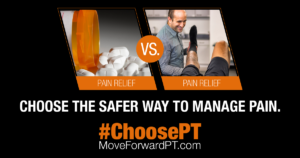
Did you know that in 2012 American health care providers wrote enough prescriptions for opiod (narcotic) pain medication for every single adult living in the United States to have a bottle? That is a staggering amount of medication – and a particular concern because this is type of medication that is extremely addictive. Opiod pain medication use is all the more concerning because it has NOT been proven to be an effective way to manage chronic pain.
Some commonly prescribed opiod pain medications are codeine, hydrocodone, Vicodin and Norco. Others are Demerol, Percoset, OxyContin, and Dilaudid.
Here are some additional eye-opening statistics published by The Centers for Disease Control and Prevention (CDC), excerpted from a summary on the MoveForwardPT.com website:
- As many as 1 in 4 people who receive prescription opioids long term for non-cancer pain in primary care settings struggles with addiction.
- Sales of prescription opioids have nearly quadrupled since 1999.
- Deaths related to prescription opioids have quadrupled.
- People addicted to prescription opioids are 40 times more likely to be addicted to heroin. Heroin-related overdose deaths more than quadrupled between 2002 and 2014.
- More than 165,000 persons in the United States have died from opioid pain-medication-related overdoses since 1999.
- Every day, more than 1,000 people are treated in emergency departments for misusing prescription opioids.
In March of 2016, the Centers for Disease Control and Prevention released guidelines recommending that healthcare providers consider opioid therapy “only if expected benefits for both pain and function are anticipated to outweigh the risks to the patient.” Before prescribing opioids, medical providers are encouraged to ensure that nonopioid therapies have been attempted and optimized. In cases when opioids are prescribed, providers are encouraged to “start low and go slow” with dosing and to combine the prescription of medication with nondrug approaches like physical therapy.
As an alternative to seeing pain relief via opiod pain medications, patients are encouraged to #ChoosePT. Physical therapists treat pain through movement, helping patients improve strength, flexibility, and range of motion. Physical therapists also can provide education to their patients about pain. Physical therapy has been supported via “high level evidence” to be effective for the treatment of multiple commonly problematic musculoskeletal conditions, such as low back pain, osteoarthritis, and muscular pain syndromes. And unlike opiod medication, physical therapy can be utilized without the risk of common pain medication side-effects like depression, overdose, addiction, or symptoms of withdrawal.
The American Physical Therapy Association has launched a national campaign called #ChoosePT, which is seeking to raise community awareness about the dangers of opiod use, as well as the benefits of safer pain management strategies, such as physical therapy. For more information about this issue, please take a look at the MoveForwardPT website: MoveForwardPT.com/ChoosePT. Feel free to also discuss this issue with us at Symmetry Physical Therapy. We would be happy to help you take an active role in safely managing your pain issues.
